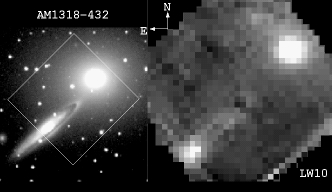The data harvest of IRAS left astronomers exhilarated at the potential of far-infrared observations, but unable to do much about it because the atmosphere both absorbs deep-IR radiation and emits copiously at these wavelengths (largely for the same reasons that water vapor is such a good greenhouse gas). The first followup to IRAS was the European Space Agency's ISO mission, launched in November 1995 into a 12-hour, highly elliptical orbit which kept it beyond the Van Allen belts for 8 hours of each orbit. Its lifetime, limited by exhaustion of the liquid helium which cooled telescope and detectors, outlasted the 18-month nominal mission and reached 28 months (finally warming up in May 1998). The telescope on ISO was the same size as that of IRAS, at 60 cm diameter. The major differences between the missions were that IRAS was optimized to survey the sky in a few broad passbands, while ISO was designed to study known targets in great detail. It carried two cameras and two spectrometers, operating from 2-240 microns.
We used ISO data to examine the properties of dust in galaxies, using overlapping glaaxies to simultaneously see the dust in emission in the infrared and in absorption in optical and near-IR light. Comparison of the two let us test for any small clumps of dust that wouldn't be effective optical absorbers, or any widespread very cold dust that would absorb visible light but contribute minimally to the far-IR. As it happened, additional data with the JCMT at longer wavelengths were important in reaching our goal. Here are some 12-micron images of galaxy pairs from the ISOCAM array. Our longer-wavelength observations all look like unresolvd dots, so they're much less visually interesting. And the upshot? As nearly as we can tell we see the same amounts of dust in emission and absorption, so that we may finally be able to see all that's there, and thus really know its role in a galaxy's development and appearance. For each picture, we show an optical image (from HST or CTIO) for reference along with the 12-micron ISO image. This filter sees mostly the warmest dust in star-forming regions, so that elliptical galaxies are very dim unless they have an active nucleus (as the one in AM1318-432 does, being a powerful radio galaxy).
 |
 |
Later, we obtained a long series of observations at 8 microns covering the 53W002 group of galaxies at redshift z=2.4 (also described under out HST and Kitt Peak observations. This wavelength gives the radiation that started out in the well-studied K band at 24 microns, and would be a sensitive indicator of the population of old, cooler stars in these objects. The reduction is turning out to be difficult because some instrumental peculiarities get worse for shorter wavelengths, so we'll get back to you on our results.
Last changes: 4/2000 © 2000